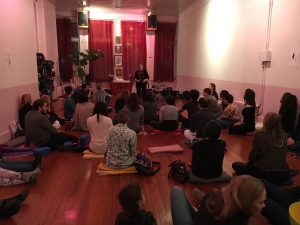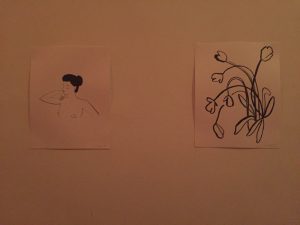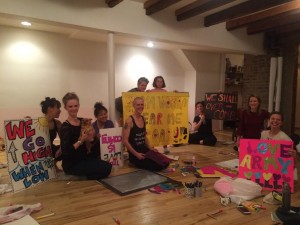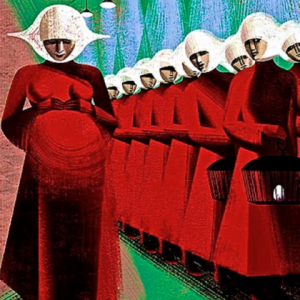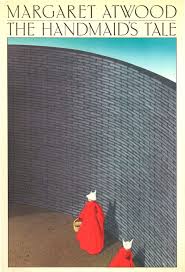The first few chilly days at the end of summer inspire a renewed look at daily routine . To encourage and promote general well-being, Ayurveda suggests instituting seasonal modifications that both reduce excess dosha from the previous season and balance the incoming season’s predominant qualities. August and September in New York is essentially a pitta/vata-season yielding gradually to vata-predominant fall. While many of the essential routines for summer continue, such as sun protection, midday activity modification, and reduction of pita aggravating foods, knowledge of the effects of pitta overload can help in negotiating the seasonal change. Continue reading
tips for the traveling yogi
shala teacher jenny campbell reflects on her recent west coast vacation, and provides helpful advice on how to practice self-care on the road.
edwin bryant
“[The] law of karma is based on the principle of cause and effect. Causes, by definition, are things which produce effects, and effects, by definition, are things coming from causes. So the principle of cause and effect is not a belief but, for most ancient Indian thinkers, a universal law that appears to govern all things.”
Scholar Edwin Bryant returns to the Shala on Friday, October 20.
practice with pride! a community night with ash + dom on friday, june 2
An open-level donation class with Ashley + Domenick
to benefit the True Colors Fund
with music by DJ Lenny Stein
followed by dancing, mingling, snacks + drinks!
Join us in practicing proudly, celebrating diversity + building community.
Come prepared to practice + dance. Please bring a beverage of your choosing.
Friday, June 2
6:30pm
The Shala
Union Square
$25 suggested donation
Sign up here!
the shala community movie night! Friday, May 5th, 7-9pm
Next up in our series of Shala gatherings: a screening of Awake: A Dream from Standing Rock, brought to you by Shala teacher Alystyre Julian. In belated observance of Earth Day, we look forward to snacking on popcorn, viewing this brand new documentary from director Josh Fox, and engaging in a consciousness-raising conversation about the intersections of social justice, environmental justice, and climate change.
May 5
7-9pm
The Shala Union Square
$20 suggested donation (all donations go to benefit the Pipeline Fighters Fund)
sutra 1.33 & the four keys
Yoga Sutras
Book 1: Sadhana Pada, Verse 33
Maria Cutrona
1.33 Maitri Karuna Muditopeksanam Sukha Duhka Punyapunya Visayanam Bhavantas Citta Prasadanam.
“By cultivating attitudes of friendliness toward the happy, compassion for the unhappy, delight in the virtuous, and disregard toward the wicked, the mind stuff retains its undisturbed calmness.” — Sri Swami Satchidananda
This is a pivotal verse in Book One of Master Patanjali’s sutras. He devotes the first verses to describing how the mind tricks us into a state of constant craving and aversion, like a 24/7 ping-pong between what you like and what you don’t like. In fact, we define ourselves by what we like and what we don’t like. Master Patanjali suggests this is our great mistake, that we are missing something finer, deeper, more pure. We are beyond our likes and dislikes, but it is extremely hard to change this habit of mind.
Swami Satchidananda suggests that if you are to learn one verse, verse 1.33 is the one to know. We understand restlessness, we understand dislike. What we don’t realize is if we give into these states we just experience more unease in the mind.
In verse I.33, Patanjali provides us with the four antidotes to feelings of judgement toward others. They are maîtri (love), karuna (compassion), mudita (joy), and upeksanam (equanimity). In Buddhism, these attitudes as The Four Immeasurables or Four Infinite Thoughts. They are referred to as infinite because ultimately the wish for our own happiness has to include the wish for everyone’s happiness.
Master Patanjali then presents the four ways in which the mind gets stuck in judgement. Known as the Four Locks, they are sukha (happy), dukha (unhappy), punya (virtuous), and apunya (wicked).
If we are to have a clear and undisturbed mind, we must apply these four “keys” to the four “locks.” It is a practice, a daily checking in with how you are feeling and a practice of shifting that feeling if necessary. We shouldn’t be thrown off balance by how we feel. Instead, check in with how the mind feels when you center your mind on “infinite love,” “infinite compassion,” “infinite joy,” or “infinite equanimity.” There is a opening, an expansiveness. You step out of the reactive mind and drop into a calm, expansive mind.
We are in challenging times. Can we go through the ups and downs of life with more peace? A yogi uses the template of life to constantly apply these practices. When one notices agitation, take pause. Allow the sense of the immeasurableness of love, compassion, joy, or equanimity to enter into your feeling body.
The focus in chapter two is meditation, or steadiness of mind. In order to have steadiness of mind we need to enhance lucidity. In order to cultivate lucidity we have to interrupt the habits of mislabeling our reality and experience. Change the habit and steady the mind. Practice ensures that at all times, no matter the circumstances, we have the four keys in our pocket.
international women’s strike + a day without a woman
Wednesday, March 8, marks the International Women’s Strike, which coincides with a Day Without A Woman. These events emphasize the intersectionality of race, gender, and class, and the complex ways in which inequality and injustice are woven through our social, cultural, political, and economic structures and systems.
we partied down for civil liberties
community night, community outreach & beyond
thank you to all who came out for the first in a series of community nights dedicated to building camaraderie and connection! sula and the noise put on an amazing show, and nathan from grownyc schooled us in urban gardening, city farmer’s markets, and progressive waste management. thanks to your generosity, we raised $600 in donations for grownyc.
our next community night is scheduled for Friday, March 3, in Union Square.
in the meantime, here are some solid resources for continued social action and engagement:
3-Part Breath
by Jenny Campbell
If you have been practicing yoga for a while, there is a good chance you have heard the yoga cue to “breathe into your heart.” The verbal assist is meant to energize the inner body of the chest, as well as open the physiological body by making more space in the sternum, widening the collar bones, creating a sense of lightness, promoting good posture, and a developing a feeling of freedom in the upper body. While this verbal cue might sound abstract, it is actually an anatomically sound instruction. When we breathe in, the diaphragm (the dome-shaped muscle primarily responsible for the act of respiration) contracts downward, creating more space for air entering the body. When we exhale, the diaphragm relaxes upwards, assisting our bodies in the release of air. This not only allows for our full, deep yoga breathing, but the pumping action of the diaphragm also massages the heart. Therefore, we can literally breathe into our hearts!
Between the winter cold and daily stress, we could all use some self-care techniques in our back pocket. Practice this exercise anytime you need to connect with your breath and de-stress. This pranayama can be practiced in any pose with a long spine and a free abdomen, such as an upright seated position, savasana, or supta baddha konasana.
3-Part Breath (Dirga Swasam Pranayama)
Find your seated or supine pose and bring your attention to your breath. Allow the breath to be continuous as you initiate your inhale from the low belly, lift the breath into the rib cage/diaphragm, and then the chest. Once you reach the top of your inhale and your chest, take a long, continuous exhale, following the same path in reverse. If helpful, you can use your hands to guide your breath as you move up and down the torso.
Inhale: one long breath into the low belly, rib cage, chest
Exhale: one long breath out through the chest, rib cage, low belly
Repeat 5-10 rounds. You may slowly start to lengthen the breath as you feel ready.
Benefits:
- Teaches one to breath fully and deeply
- Can calm and ground the mind
- Can help to decrease stress and anxiety
- Can help one to focus on the present moment
*Proceed with caution with this and all breathing exercises, especially if you have a respiratory condition. As with all pranayama, stop if you feel light headed.
women’s march prep
teacher sherry russell recently called on the shala’s love army to generate signage for the women’s marches happening in washington, d.c. and here in nyc (not to mention all over the country!). we think these gorgeous signs and banners will lend some much-needed color and joyful tenacity to the enormous gatherings taking place this inauguration weekend.
self-care at the shala
on a mild evening in early january, maria rubinate and ashley dorr treated both new and familiar faces to a cozy self-care workshop, including light asana practice, pranayama, art therapy, and a tutorial in seasonal ayurveda. one of the focuses of the workshop was how to identify and address symptoms of vicarious trauma as a result of intense, challenging, and emotionally-charged fields of works. it was a remarkably educational and soothing event, and we’re excited to hear that maria and ashley are considering making this a regular happening.
post-election meditation with sharon salzberg
Tina’s Dhal
by Bibi Lorenzetti
One of my favorite winter foods is dhal. Dhal is a type of legume, usually split yellow or orange lentil. There are many different ways of making dhal soup, which tends to be nourishing and balancing for all doshas, depending on preparation.
I learned the following recipe from my cooking teacher in India, who is known to Westerners as Tina. She works on a camping stove set on a big rock in her living room. We gather around as she talks us through each step of cooking traditional Indian food. When the meal is ready, we—Tina, her students, family, and dogs—go outside to sit and eat together on big floor pillows in the shade of colorful fabrics.
For a while, I was making Tina’s dhal for special order at the Shala. I would pack a cart full of jars and wheel it from my Greenpoint apartment to the Bedford L, all the way to the Shala fridge. It was fun, but a lot of work! For those of you who enjoyed it and ordered it weekly, follow these steps.
You will need:
- A Dutch oven, otherwise known as a cast-iron pot
- A wooden spoon
- Measuring cups
- Grater
- Pan or small pot
- Stainer
- Bowl
- Spoon
Ingredients:
- 1 1/3 cups of yellow or orange dhal
- 3 1/2 tbsp ghee
- 1 tsp turmeric (I like to buy it fresh and grate, so I do 2 tsp turmeric; if you use powder then 1 tsp is enough)
- 1 tsp coriander, ground
- 1 tbsp fresh ginger, grated
- 5 cups water
- 1/2 tsp cumin seeds
- 1 tsp mustard seeds
- 2 cloves
- 1 tsp cardamom seeds
- Pinch of asafoetida
- 1 garlic cloves, mashed
- 4 dried red chili peppers (broken up)
- Salt
- A few stems of cilantro (to be chopped and added at the end)
Instructions:
Soak the dhal in a bowl with cold water for an hour. Drain and wash under cold water until water runs clear.
Transfer the dhal to the pot together with water, and turmeric. Cover and bring to a boil. Once the water is boiling, remove the residue that rises to the top. Reduce heat. Add salt. Simmer for about 20 minutes, or until you see the dhal is getting mushy and soft, a paste-like consistency. Stir frequently throughout this process.
In a separate pan, melt ghee over medium heat. Add dried chilis, garlic, mustard and coriander seeds, grated turmeric and ginger. Stir seeds pop, then add the rest of powdered spices and fry for a few more minutes, stirring. Make sure the flame is low enough that seeds don’t burn and ghee does not dry up. You can always add a little more ghee if needed!
When dhal is ready (mushy, and water has been nearly completely absorbed), add the ghee and spice mixture to dhal and cook for a few minutes on low flame. Cover and let sit. Add cilantro as garnish upon serving.
P.S.
Balancing Doshas
Depending on your predominant dosha, you may want to add more or less of the following:
Grounding spices for vata: cardamom, fennel, nutmeg, asafoetida, cinnamon, cloves, coriander, cumin, black pepper, cayenne, mustard seeds, turmeric, ginger, garlic, chilis.
Cooling spices for pitta: cardamom, coriander, cilantro, fennel, cumin, turmeric, mint, parsley.
Warming spices for kapha: black pepper, cardamom, cayenne, cloves, garlic, ginger, mustard seeds, turmeric, asafoetida, cilantro, coriander, cumin, parsley, cinnamon.
why essential oils?
By Julie Peacock
Are you using essential oils for your health and wellness yet? It’s amazing how healing and beneficial essential oils can be for your body, mind, and spirit. They have the power to lift the spirits, conjure up powerful memories, boost your energy, calm your nervous system, assist in healing the body, clean your home, and so much more.
I’ve been using essential oils for years, but once I discovered the certified pure therapeutic oils (CPTG) that doTERRA makes, I have experienced their many benefits—in my practice, with my kids, and with my clients. Consider peppermint. Peppermint not only freshens the breath, but can be used to soothe digestion, cool the body, help with focus, and relieve various aches and pains.
The other day, right before my Mysore practice, I was experiencing a tension headache. Instead of popping a couple of Advil, I dabbed a drop of peppermint on each of my temples and at the base of my skull. My headache was gone within minutes. And that’s just one way to use peppermint—there are so many others!
Check out my November 5th workshop (12pm-2:30pm at The Shala Union Square), where we’ll practice getting grounded using yoga, nutrition, and essential oils. See more information here.
fort greene garden
our fort greene garden has come a long way!
thank you to all the students and teachers who kept our garden watered and cared for this summer. it looks beautiful and well-loved!
pratyahara
II.55 tataḥ parama vaśyatā indriyāṇāḿ
tataḥ: then, from that
parama: the highest
vaśyatā: subdued, controlled, governed
indriyāṇāḿ: of the senses
Pratyahara results in the absolute control of the sense organs. (Source: Light on the Yoga Sutras of Patanjali, B.K.S. Iyengar)
*
Pratyahara is the fifth limb of Patanjali’s eight-limbed path of practice. It is the process of withdrawing the senses (indriyas) from objects of distraction, desire, or aversion, both outside of and within the mind. This prepares us for equanimous concentration (dharana) and meditation (dhyana). Like tributaries moving toward a greater body of water, the busy, individual trajectories of the eyes, ears, nose, mouth, and skin are redirected for the purpose of reflection and insight.
— Melanie Jane Parker
summer reading: shala book club
with our next book club meeting slated for october 1, we are excited to announce paul beatty’s the sellout as our summer reading selection.
described by Kevin Young of the New York Times as a “metaphorical multicultural pot almost too hot to touch,” the sellout most certainly stands on its own. we have, however, selected two powerful supporting texts to be read alongside beatty’s brilliant satire: citizen by claudia rankine and between the world and me by ta-nehisi coates.
please read one, two, or all three books in preparation for our discussion and potluck in september! date and time TBD.




